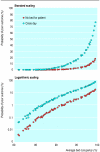Dynamics of bed use in accommodating emergency admissions: stochastic simulation model
- PMID: 10406748
- PMCID: PMC28163
- DOI: 10.1136/bmj.319.7203.155
Dynamics of bed use in accommodating emergency admissions: stochastic simulation model
Abstract
Objective: To examine the daily bed requirements arising from the flow of emergency admissions to an acute hospital, to identify the implications of fluctuating and unpredictable demands for emergency admission for the management of hospital bed capacity, and to quantify the daily risk of insufficient capacity for patients requiring immediate admission.
Design: Modelling of the dynamics of the hospital system, using a discrete-event stochastic simulation model, which reflects the relation between demand and available bed capacity.
Setting: Hypothetical acute hospital in England.
Subjects: Simulated emergency admissions of all types except mental disorder.
Main outcome measures: The risk of having no bed available for any patient requiring immediate admission; the daily risk that there is no bed available for at least one patient requiring immediate admission; the mean bed occupancy rate.
Results: Risks are discernible when average bed occupancy rates exceed about 85%, and an acute hospital can expect regular bed shortages and periodic bed crises if average bed occupancy rises to 90% or more.
Conclusions: There are limits to the occupancy rates that can be achieved safely without considerable risk to patients and to the efficient delivery of emergency care. Spare bed capacity is therefore essential for the effective management of emergency admissions, and its cost should be borne by purchasers as an essential element of an acute hospital service.
Figures
Comment in
-
Politics surrounding last winter's flu crisis. NHS's fundamental problems must be solved.BMJ. 2000 May 13;320(7245):1336. BMJ. 2000. PMID: 10885911 Free PMC article. No abstract available.
References
-
- Kendrick S. The pattern of increase in emergency hospital admissions in Scotland. Health Bull. 1996;54:169–183. - PubMed
-
- Kendrick S, Frame S, Povey C. Beds occupied by emergency patients: long term trends in patterns of short term fluctuations in Scotland. Health Bulletin. 1997;55:167–175. - PubMed
-
- Crossen-White H, Moss P, Morris D, Di Blasi Z, Lambert M, Russell I, et al. The rise in emergency admissions. Report to the West Midlands NHS Executive. 1998. (Available from York Health Economics Consortium, University of York.)
Publication types
MeSH terms
LinkOut - more resources
Full Text Sources
Medical

